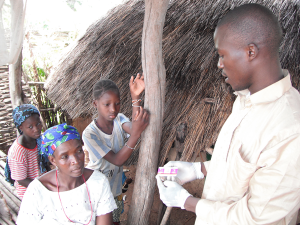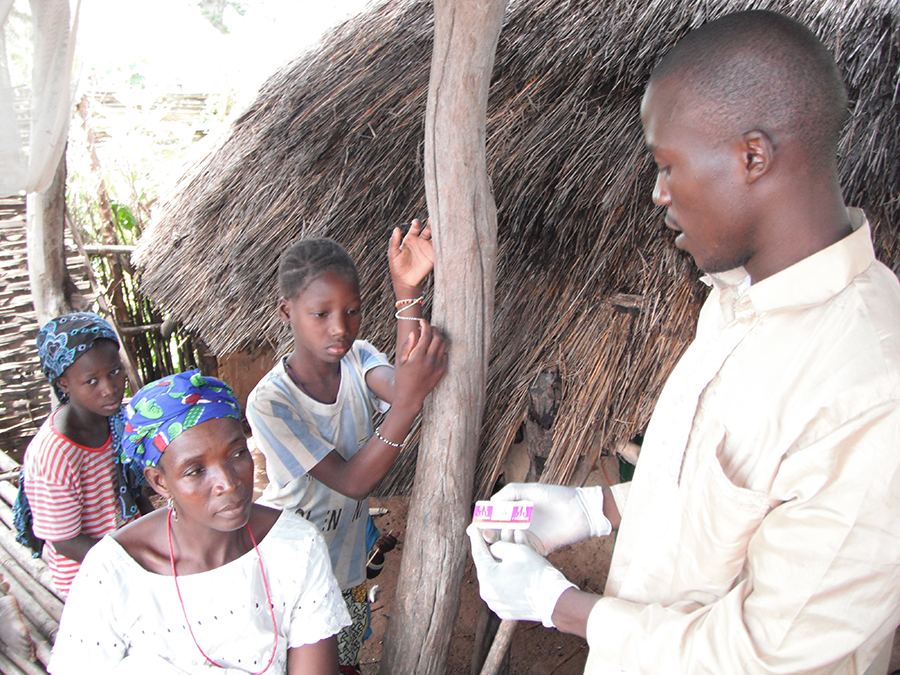Documenting SBCC’s Important Role in Malaria Case Management

Community health worker Cheikh Tandian in southern Senegal during routine sweeps of villages with RDTs and ACTs. Photo by Ian Hennessee
Are there examples of effective social and behavior change communication (SBCC) for malaria case management that can be shared with other countries looking to improve their programming?
After examining research, policy documents and program evaluations from Ethiopia, Rwanda, Senegal and Zambia to determine whether effective SBCC activities have been used to improve malaria case management, I haven’t come across many strong examples. Program reports don’t tend to mention SBCC program evaluation. Reports that do mention it are difficult to find credible because the indicators used don’t address the real determinants of behavior.
Behavioral researchers have spent decades trying to illustrate just how insufficient it is to measure only knowledge. Attitudinal factors like perceived risk, self-efficacy and cultural norms are important behavioral determinants conspicuously missing from reports on malaria case management program design and evaluation.
Here’s an example of an attitudinal indicator related to malaria case management: Proportion of health care service providers that believe new diagnosis and treatment guidelines (test before you treat) are effective. I found a carefully designed study (a cluster-randomized controlled trial) assessing community health workers ability to diagnose and treat children. After a brief training, health workers evaluated over a thousand children with fever and accurately treated them based on disease classification 94%-100% of the time. Of note in this study: facility-based health workers (nurses or doctors) in two districts of the Southern Province of Zambia were less likely to follow guidelines or honor the results of rapid diagnostic tests than community health workers.
MalariaCare recently conducted a series of interviews revealing the same pattern. A 2014 systematic review on malaria in pregnancy found health care provider reliance on clinical diagnosis and poor adherence to treatment policy is a consistent problem. Perhaps doctors feel their considerable experience enables them to diagnose patients accurately without policy-mandated tests? Do community health workers adhere to a policy more tightly because they have a limited number of tasks and take pride in fastidiously carrying them out? The point is that the most educated individuals in an entire country – or those most likely to have accurate, timely information – can be outperformed by individuals with little or no formal education when exposed to the exact same set of government guidelines.
The difference is attitude.
Are programs targeting the attitudinal barriers behind adherence to malaria test results? Are evaluators measuring changes in these key attitudes? You can’t measure impact if you didn’t actually change behavior and people don’t change the way they act unless their decision-making process – in all of its beautiful human complexity – is acknowledged and addressed.
The Roll Back Malaria Partnership (RBM) has an SBCC community of practice made up of public health professionals working to promote a more rigorous, evidence-based approach to malaria SBCC program design and evaluation. One of the group’s products, the Malaria Behavior Change Communication Indicator Reference Guide, was developed to help Ministries of Health, donor agencies and implementing partners design and measure levels of behavior change related to malaria prevention and case management. The guide contains a list of indicators that go beyond knowledge and awareness into important behavioral determinants like attitudes. The guide has been available since February 2014 and this month the group is happy to announce its publication in Portuguese (it is also available in French and English).
The answer to the question posed by this desk review is that there is a lot of great work being done in malaria case management but it is being in done in a way that makes it difficult for others to follow. This new tool was developed to ensure SBCC programming is designed in such a way that its impact can be measured and replicated.








Leave a Reply
Want to join the discussion?Feel free to contribute!